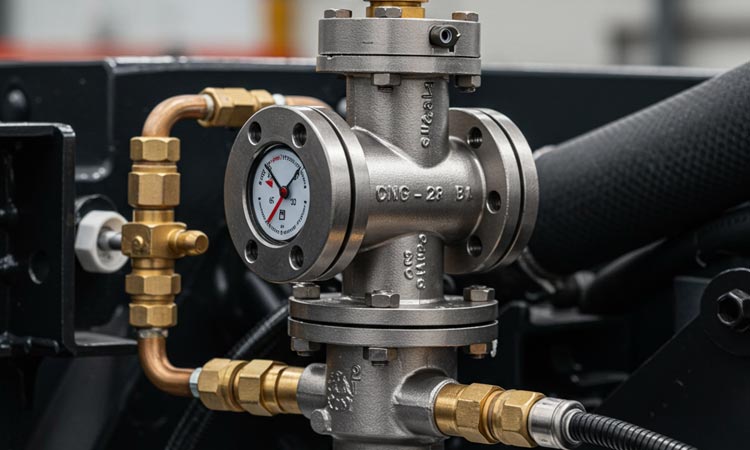Vehicle-mounted compressed natural gas (CNG) cylinder valves are critical safety components in buses, trucks, and other heavy-duty natural gas vehicles. These valve assemblies do much more than simply open or close the fuel flow: they house multiple integrated functions to secure and regulate the high-pressure gas. In practice, each cylinder’s valve combines a manual or solenoid-operated shutoff, flow-control devices, and pressure-relief elements in a single rugged unit. Modern designs incorporate built-in PRDs (pressure-relief devices) and thermal fusible plugs in the cylinder valve body, ensuring that any excess pressure or fire exposure causes safe venting before a tank rupture. For working pressures up to 200–250 bar, these composite valves must remain leak-tight through millions of operating cycles and extreme temperature swings. Below we summarize the key design features and typical applications of vehicle CNG cylinder valves, concluding with how Chunhe’s engineered solutions address these requirements.
Technical Features of CNG Cylinder Valves
Modern CNG cylinder valves integrate several safety and control features. The valve body contains a high-pressure shutoff mechanism plus devices to manage abnormal conditions. The main design elements of a heavy-duty CNG cylinder valve include:
Flow Shut-off and Check Valve: A robust ball-valve mechanism (operated by a handwheel or by a 12–24 V solenoid) provides the primary on/off control of the fuel. Many designs also incorporate an internal check or excess-flow element: if a downstream line ruptures, the sudden high flow causes the valve’s flow limiter to automatically shut off flow and then reset when normal conditions return.
Pressure-Relief Device (PRD): Every CNG cylinder valve is equipped with one or more safety relief devices to prevent overpressure. This typically includes a rupture disc and/or a thermally-sensitive fusible plug that melts at ~100°C, releasing gas safely in case of fire exposure. These devices are integrated directly into the valve body.
Thermal Protection: Cylinder valves often include thermal devices like spring-loaded valves or fusible discs that activate at elevated temperatures to vent gas. Protective housings direct any vented gas safely away from the vehicle.
Optional Flow-Limiter (Excess-Flow) Feature: Some valves include flow-limiters that activate on sudden high flow (e.g., in the event of a pipe break) and automatically reset once the abnormal condition passes.
Construction and Materials: Cylinder valves are typically made of brass or nickel-plated steel and use high-grade O-rings or metal-to-metal seals. They are designed to withstand high pressure and vibration, meeting rigorous leak and burst tests under relevant automotive standards.
In summary, a modern vehicle cylinder valve is a multi-function assembly that provides shutoff, excess-flow control, pressure relief, and thermal safety in a single unit — essentially a small, stand-alone safety system.
Practical Applications in Heavy-Duty Vehicles
These valves are essential in transit buses, refuse trucks, long-haul lorries, and other commercial vehicles. Multiple high-pressure cylinders are usually mounted on the vehicle (on the roof or chassis), and each has its own valve. These valves allow for refueling, normal fuel supply, and emergency shutoff. In an emergency, the built-in PRDs release pressure safely to prevent tank rupture.
Heavy-duty environments impose demanding requirements. Bus valves endure engine vibration, temperature swings, and regular inspection cycles. Long-haul trucks require tightness under highway vibration and weather exposure. Fire regulations also mandate that discharged gas be routed safely via manifolds or protective valve covers. Because the cylinder valve is the front-line control point, its reliability directly affects safety and vehicle uptime.
Fleet operators and first responders alike rely on cylinder valve safety features — such as PRDs and fusible plugs — and are trained to use manual shutoff in emergencies. These valves, by integrating safety and control functions, enable the safe daily use of high-pressure natural gas in commercial vehicles.
Chunhe’s Complete CNG Valve Solutions
To meet these demands, Chunhe offers a comprehensive range of vehicle-mounted CNG cylinder valves designed for pressures up to 25 MPa and temperatures from –40°C to +85°C. Each valve includes built-in safety devices — pressure-relief modules, fusible plugs, and optional flow-limiters — to support compliance with global NGV standards. Made from CNC-machined brass and featuring premium seals, Chunhe valves are engineered for durability and leak-tight performance.
Whether it’s a single-cylinder bus valve with solenoid and PRD, or a bank of valves for a long-haul fleet, Chunhe provides the matching solution. All products are factory-tested, fully documented, and designed to simplify system integration.
In conclusion, modern CNG cylinder valves are essential to the safety and reliability of heavy-duty natural gas vehicles. They integrate pressure relief, flow control, and thermal protection into a compact, robust assembly. Chunhe’s vehicle valve series delivers complete solutions — helping CNG fleets operate more safely, more reliably, and with peace of mind.

